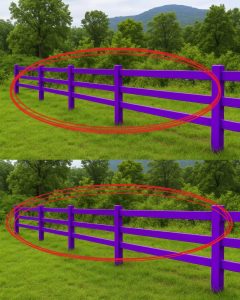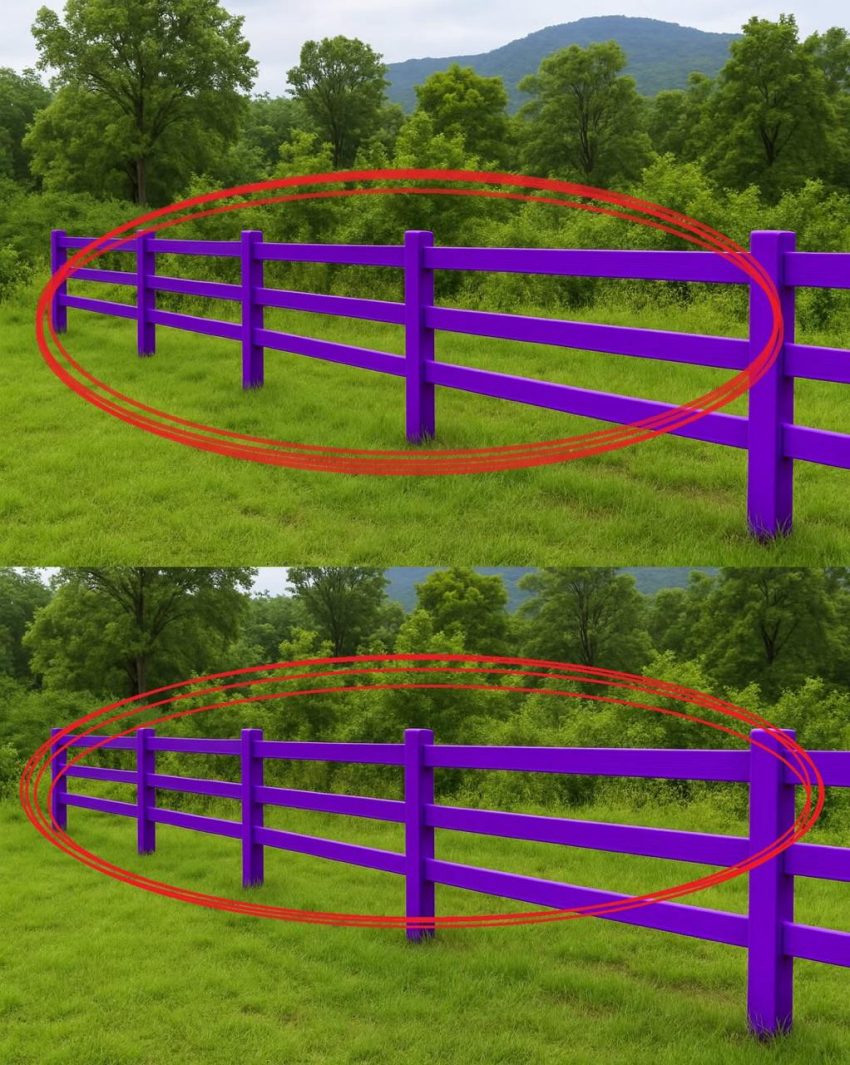When you’re going along a quiet country road or hiking along a trail, you could discover something strange: a fencepost painted dark purple. It shows that there is a purpose, not randomness, art, or a trend.
That line of purple paint means something important that everyone who lives in the country, travels there, or owns land should know.
In some parts of the US, a purple fence or tree symbolizes “No Trespassing.”

The Purple Fence Mystery
Landowners in the country have trouble keeping “No Trespassing” signs from falling off, fading in the sun, or being stolen for years. It was inconvenient and costly to have to buy new ones. So legislators in a few states came up with a simpler, smarter solution that nature couldn’t easily get rid of: purple paint marks.
In some states, a single purple line might imply the same thing as a sign that is printed. If someone crosses past the property line, they can be prosecuted with trespassing, just like if they had violated a sign that indicated not to.
What makes it purple? Purple is a color that shines out. It sticks out from trees, grass, and fences because it is bright enough to see and not something you see every day. Purple is a color that stands out and is courteous. Red and orange, on the other hand, are often employed for hunting or danger zones.
The Rules for Using the Paint
Before you get a brush and a bucket, you need to know that purple paint isn’t supposed to be random. There are rules concerning how and where to use it in states that allow it.
Most laws mention this:
1. Stripes that go up and down only
It is not okay to splatter, scribble, or utilize the mark as a design. It must be painted straight up and down. The vertical stripe is there on purpose to convey that it is meant to be a warning, not a decoration.
2. Size and how easy it is to view are crucial.
From a distance, it should be easy to see each mark, and they should be at least eight inches long and one inch wide. If it’s smaller, it can look like a stain or damage from the weather.
3. The tree or fence is tall enough.
If you are of medium height, the wall should be painted between three and five feet off the ground. If it’s too low, it will be lost in the long grass. A hiker or visitor could not notice it at all if it’s too high.
4. Make it the same
Putting markings every 100 feet along property borders or limits is a typical practice. This spacing makes sure that no one accidentally crosses the line without seeing the markings.
These small details make the marking legally binding and simple for hunters, hikers, and neighbors to observe.
States Where Purple Paint Is Required
The “Purple Paint Law” has been passed in more than a dozen U.S. states thus far. Some of them are:
Texas
North Carolina
Illinois
Kansas
Missouri
In Indiana
Florida
Pennsylvania
Arkansas
The wording is different in each state, but the meaning is the same: purple paint is a clear, visible border marker that works just like a “No Trespassing” sign.
If you live somewhere else, please make sure you know the property laws in your area before using the system. It might not be legal in countries that don’t have regulations against purple paint, but it still gets people’s attention.
The Purple Paint Law: How It Works
It can seem unusual at first to paint fences and trees purple, but there is an excellent purpose for it.
It lasts longer. Signs made of paper or metal fade, corrode, or blow away faster than paint.
It’s a great deal. A few cans of paint can last for years and cover a lot of ground.
It is better for the earth. There will be less rubbish and waste on rural land if there are fewer plastic signs.
The signs are easy to notice, yet they don’t give too much information at once. You can see the message without turning a peaceful country view into a wall of warnings.
The purple line is also a courtesy for individuals who hike, camp, or explore. It tells you where private land begins, which could help you avoid misunderstandings, fines, or uncomfortable conversations with property owners.
What the Color Means Purple has long been a symbol of respect, dignity, and protection, all of which fit in perfectly with its current legal meaning. A purple mark doesn’t furiously say “Keep Out”; it quietly says, “This space belongs to someone—please respect it.”
Land isn’t the only thing that makes up property in rural America. It’s the family’s history, the work they’ve done, and often the effort of many generations. It’s a simple and beautiful way to remember.
If You See a Purple Fence, Here’s What to Do
When you’re walking or driving, bear this in mind whenever you see a fence, post, or tree with a purple mark on it:
Even if there aren’t any additional signs, don’t go past the line.
Your pets, cars, and hunting gear should stay on your side of the line.
Check maps or ask someone who lives nearby if you’re not sure if a trail or field is public.
It’s not only about not getting in trouble; it’s also about respecting the silent code of respect that rural communities still hold dear.
This code can be used responsibly by homeowners if they follow its rules.
If you own property and are thinking about painting it purple,
Choose an outside paint that will last a long time and hold up to the weather. The finest kind is one that is meant to designate trees or fences outside.
When you mark the lines on your land, be careful and do it the same way every time.
Let your neighbors know what it means so they do. A lot of them would probably want the clarity.
Keep a record or image of your markings in case you need to clarify something later.
This easy technique makes sure that your boundaries are lawful and that anyone close can see them.
The Next Time You See That Shade…
When you’re out on a trail and spot a purple line on a tree or fencepost, stop and look. You just saw a sign that says this region is loved, cared for, and protected. It’s a way for people in the country to chat to each other without being loud.
It’s not about being rude. Respect is the most important thing.
A purple fence isn’t an odd choice for fashion or decoration. It’s a voice, calm and sure, that has been around for hundreds of years. It reminds us that every piece of land has a story, a caretaker, and a boundary that should be respected.
